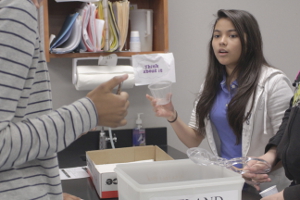Teaching Kids to Argue Critical Thinking and the Scientific Method
Timothy Huneycutt |
January 2, 2014
 There exists among members of our society a stigma against arguing. From a young age, children are told not to bicker and quarrel, and many adults tend to purposefully avoid conflict because getting into an “argument” is something that is viewed as bad and punishable. However, the act of arguing is not as bad as we make it out to be. When used properly, arguing is really just an extension of critical thinking and analysis. To elaborate more on the subject, NMSI’s expert science coordinator Robert Gonzales affirms our position that the skill of arguing is something every student should learn and master.
There exists among members of our society a stigma against arguing. From a young age, children are told not to bicker and quarrel, and many adults tend to purposefully avoid conflict because getting into an “argument” is something that is viewed as bad and punishable. However, the act of arguing is not as bad as we make it out to be. When used properly, arguing is really just an extension of critical thinking and analysis. To elaborate more on the subject, NMSI’s expert science coordinator Robert Gonzales affirms our position that the skill of arguing is something every student should learn and master.
According to Gonzales, many of the greatest scientific laws and theories would not have been discovered and developed without argumentation. Thus, when put into thecontext of the scientific method, arguing can be incredibly insightful and beneficial. “We argue to understand other people’s perspectives and to strengthen our own,” says Gonzales. “It is only the arguers and the topic of discourse that affect the productivity and professionalism of the argument.” In other words, arguments are only as damaging and negative – or constructive and positive – as the arguers involved. Therefore, from an academic and scientific point of view, it is important for teachers to help students understand how to argue and evaluate ideas effectively. According to Gonzales, there are three core things teachers must do when it comes to helping their students learn how to argue.
1.Encourage exploration. Children are naturally curious about the world around them. They spontaneously create things and interact with objects as if the world is their playground, and they ask why things happen and how things work. In short, children intuitively exhibit signs of reasoning and deduction, both of which are processes that help scientists make justified claims and explanations about the world. Therefore, it is important for teachers to capitalize on this curiosity with engaging activities – such as NMSI’s free lessons – that will develop students’ critical thinking skills and emerge them in the learning process.
2.Encourage demonstration. Expanding on the idea of student engagement through exploration, it is also important for teachers to ask their students to demonstrate their understanding of the topic at hand. This is a vital step for students when it comes to attaining conceptual understanding and appreciating the strengths/weaknesses of a theory, and it helps them to better form their own scientific ideas and arguments, all of which are elements found within the scientific method. Flipping the classroom is a great way to increase this type of student participation. Instead of hearing the teacher lecture in the classroom, students watch lecture videos at home, resulting in more time in class for peer-to-peer argumentation and active demonstration.
3.Encourage internal argument. According to Gonzales, internal argument is “a very necessary aspect of problem solving and one of the most valuable metacognitive tools.” When a teacher is encouraging a student to engage in this type of inner-dialogue, it forces the student to think critically about their stance on the issue at hand and their solution to the problem. Do I agree with myself? Are there holes in my work? Is there a better alternative? These are the kinds of questions students must ask themselves to develop their reasoning/argumentative skills as they learn how to think within the context of the scientific method, and Gonzales says that “engaging in arguments with peers strengthens this kind of evaluative tool. It is an essential habit-of-mind a scientist must possess.”